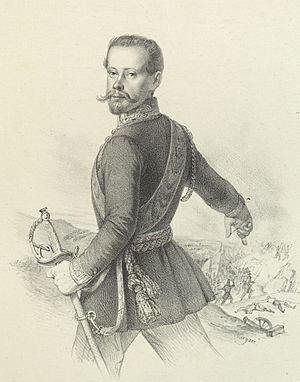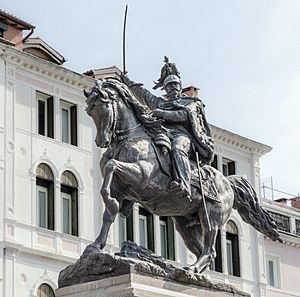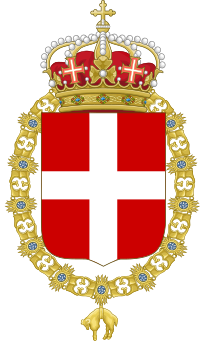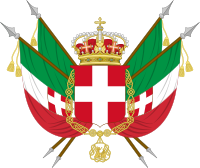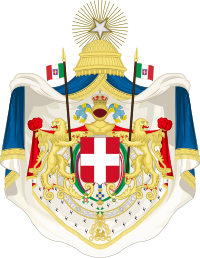Victor Emmanuel II facts for kids
Quick facts for kids Victor Emmanuel II |
|||||
|---|---|---|---|---|---|
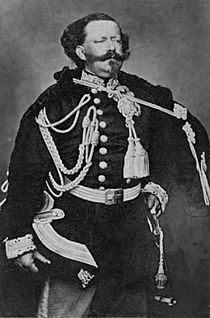
Victor Emmanuel c. 1861, by Disdéri
|
|||||
| King of Italy (more...) | |||||
| Reign | 17 March 1861 – 9 January 1878 | ||||
| Predecessor | Napoleon (1814) | ||||
| Successor | Umberto I | ||||
| Prime Ministers |
See list
|
||||
| King of Sardinia and Duke of Savoy | |||||
| Reign | 23 March 1849 – 17 March 1861 | ||||
| Predecessor | Charles Albert | ||||
| Prime Ministers |
See list
|
||||
| Born | 14 March 1820 Palazzo Carignano, Turin, Kingdom of Sardinia |
||||
| Died | 9 January 1878 (aged 57) Quirinal Palace, Rome, Kingdom of Italy |
||||
| Burial | Pantheon, Rome | ||||
| Spouse | |||||
| Issue see details... |
|
||||
|
|||||
| House | Savoy-Carignano | ||||
| Father | Charles Albert of Sardinia | ||||
| Mother | Maria Theresa of Austria | ||||
| Religion | Roman Catholicism | ||||
| Signature | |||||
Victor Emmanuel II (born 14 March 1820 – died 9 January 1878) was the last King of Sardinia. He ruled from 1849 until 1861. On 17 March 1861, he became the first King of Italy. This was the first time Italy had been a united country since the 6th century. He was given the nickname Father of the Fatherland (Italian: Padre della Patria) by the Italian people.
Victor Emmanuel was born in Turin. He was the oldest son of Charles Albert, Prince of Carignano, and Maria Theresa of Austria. He fought in the First Italian War of Independence (1848–1849). After his father stepped down, Victor Emmanuel became King of Piedmont-Sardinia. He chose Camillo Benso, Count of Cavour, as his Prime Minister.
In 1855, he sent troops to help France and Britain in the Crimean War. This helped Sardinia gain a voice at the peace conference. It allowed Victor Emmanuel to become friends with Napoleon III, the Emperor of France. France then helped Sardinia in the Second Italian War of Independence. This war freed Lombardy from Austrian rule.
Victor Emmanuel supported Giuseppe Garibaldi's Expedition of the Thousand (1860–1861). This led to the quick fall of the Kingdom of the Two Sicilies in southern Italy. However, Victor Emmanuel stopped Garibaldi from attacking Rome. Rome was still under the Papal States and protected by France. In 1860, regions like Tuscany and Modena joined Sardinia-Piedmont. Victor Emmanuel then marched into Marche and Umbria, winning a battle against the Pope's forces. This led to him being excommunicated from the Catholic Church until just before his death in 1878. He later met Garibaldi and took control of southern Italy. He became the first King of Italy on 17 March 1861.
In 1866, the Third Italian War of Independence allowed Italy to gain Veneto. In 1870, Victor Emmanuel also took advantage of France's defeat in the Franco-Prussian War. He was able to conquer the Papal States after French troops left. He entered Rome on 20 September 1870. Rome became the new capital on 2 July 1871. He died in Rome in 1878 and was buried in the Pantheon.
A large monument in Rome, the Victor Emmanuel II monument, was built to honor him. It includes the Altare della Patria.
Contents
Victor Emmanuel II: Italy's First King
Victor Emmanuel was born the oldest son of Carlo Alberto, Prince of Carignano. His mother was Maria Theresa of Austria. His father became King of Sardinia-Piedmont in 1831. Victor Emmanuel spent some of his youth in Florence. He was very interested in politics, the military, and sports. In 1842, he married his cousin, Adelaide of Austria. Before becoming king, he was known as the Duke of Savoy.
He fought in the First Italian War of Independence (1848–1849). He fought alongside his father, King Charles Albert. He was on the front lines in battles like Pastrengo and Goito.
Becoming King of Sardinia
He became King of Sardinia-Piedmont in 1849. This happened after his father gave up the throne. His father had been defeated by the Austrians at the Battle of Novara. Victor Emmanuel quickly got a good peace deal from the Austrian commander. However, the Piedmontese Parliament did not approve the treaty. Victor Emmanuel then replaced his Prime Minister. After new elections, the peace with Austria was accepted.
In 1852, he chose Count Camillo Benso of Cavour as his Prime Minister. This was a smart decision. Cavour was a very skilled politician. He played a huge role in uniting Italy. Victor Emmanuel II soon became a symbol of the "Risorgimento". This was the movement to unite Italy in the 1850s and 60s. He was popular because he respected the new constitution and made liberal changes.
The Crimean War and Alliances

Victor Emmanuel advised Cavour to join Britain and France in the Crimean War against Russia. Cavour was not sure about going to war. But Victor Emmanuel believed in the benefits of allying with Britain and France.
After the war, Cavour met secretly with Napoleon III of France. In 1858, they agreed that France would help Piedmont fight Austria. Austria still controlled Kingdom of Lombardy–Venetia in northern Italy. In return, France would receive Nice and Savoy.
Uniting Italy Through Wars
The war against Austria in 1859 started well for Italy and France. But Napoleon III worried about the war's costs and Prussian troops. He secretly made a treaty with Franz Joseph of Austria. Piedmont would only gain Lombardy. France did not get Nice and Savoy at this time. Austria kept Veneto, which was a big problem for Piedmont. Cavour resigned after arguments about the war's outcome. France only gained Nice and Savoy in March 1860. This happened after Cavour became Prime Minister again.
Later that year, Victor Emmanuel II sent his army to fight the Pope's army. He pushed the Pope's forces back to Vatican City. Because of this, he was excommunicated from the Catholic Church. This lasted until 1878, just before he died. Then, Giuseppe Garibaldi conquered Sicily and Naples. Sardinia-Piedmont grew even larger. On 17 March 1861, the Kingdom of Italy was officially created. Victor Emmanuel II became its first king.
Victor Emmanuel supported Giuseppe Garibaldi's Expedition of the Thousand (1860–1861). This led to the quick fall of the Kingdom of the Two Sicilies in southern Italy. However, the king stopped Garibaldi from attacking Rome. Rome was still under the Papal States and protected by France. In 1860, regions like Tuscany and Parma voted to join Sardinia-Piedmont. Victor Emmanuel then marched into Marche and Umbria. He won the battle of Castelfidardo (1860) against the Papal forces.
The king later met Garibaldi at Teano. Garibaldi gave him control of southern Italy. More votes in the newly taken lands led to Victor Emmanuel being named the first King of Italy. This happened on 17 March 1861. He kept his title as Victor Emmanuel II, not Victor Emmanuel I of Italy. Turin became the capital of the new country. Only Rome, Veneto, and Trentino still needed to be united.
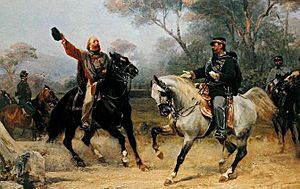
Completing the Unification
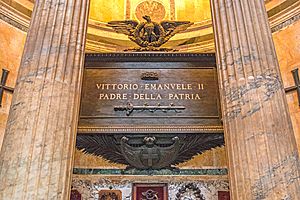
In 1866, Victor Emmanuel joined with Prussia in the Third Italian War of Independence. Even though Italy did not win all its battles, he still gained Veneto. This was because Austria was defeated by Germany. In 1870, after Garibaldi's attempts failed, Victor Emmanuel took advantage of the Prussian victory over France. He captured Rome after the French troops left. He entered Rome on 20 September 1870. Rome became the new capital on 2 July 1871. The new Royal residence was the Quirinal Palace.
The rest of Victor Emmanuel II's rule was much calmer. His role in daily governing slowly decreased. It became clear that a king could not keep a government in power against the will of Parliament. So, ministers became responsible to Parliament, not just the king.
Victor Emmanuel died in Rome in 1878. He met with representatives of Pope Pius IX, who lifted his excommunication. He was buried in the Pantheon. His son, Umberto I, became the next king.
Family and Children
In 1842, Victor Emmanuel married his cousin, Adelaide of Austria (1822–1855). They had eight children:
- Maria Clotilde (1843–1911), who married Napoléon Joseph.
- Umberto (1844–1900), who later became King of Italy. He married his cousin Margherita of Savoy.
- Amadeo (1845–1890), who later became King of Spain. He married Maria Vittoria dal Pozzo.
- Oddone Eugenio Maria (1846–1866), Duke of Montferrat.
- Maria Pia (1847–1911), who married King Louis of Portugal.
- Carlo Alberto (1851–1854), Duke of Chablais.
- Vittorio Emanuele (born and died 1852).
- Vittorio Emanuele (1855–1855), Count of Geneva.
In 1869, he married his main mistress, Rosa Vercellana (1833–1885). She was known as "Bela Rosin" in Piedmontese. She was not from a noble family but was made Countess in 1858. They had two children:
- Vittoria Guerrieri (1848–1905).
- Emanuele Alberto Guerrieri (1851–1894), Count of Mirafiori and Fontanafredda.
Victor Emmanuel II also had other children with different mothers:
- Maria Emanuela Alberta Vittoria Guerrieri di Roverbella (1853–1890).
- Savoiarda of Savoy (1856–1885).
- Donato Etna (1858–1938), who became a soldier.
- Vittorio di Rho (1861–1913), a notable photographer.
- Maria Pia di Rho (1866–1947).
- Domenico Scarpetta (1876–1952), an actor.
Honours and Awards
| Styles of King Victor Emmanuel II |
|
|---|---|
 |
|
| Reference style | His Majesty |
| Spoken style | Your Majesty |
Italian Awards
- Knight of the Supreme Order of the Most Holy Annunciation, 1836
- Grand Cross of the Order of Saints Maurice and Lazarus, 1836
- Grand Master of the Military Order of Savoy
- Grand Master of the Order of the Crown of Italy
- Grand Master of the Civil Order of Savoy
- Gold Medal of Military Valour
- Silver Medal of Military Valour
- Medal of the Liberation of Rome (1849–1870)
- Commemorative Medal of Campaigns of Independence Wars
- Commemorative Medal of the Unity of Italy
 Tuscan Grand Ducal family: Grand Cross of the Order of Saint Joseph
Tuscan Grand Ducal family: Grand Cross of the Order of Saint Joseph
Foreign Awards
 Austrian Empire:
Austrian Empire:
- Knight of the Order of the Golden Fleece, 1841
- Grand Cross of the Order of St. Stephen, 1869
 Baden:
Baden:
- Knight of the House Order of Fidelity, 1864
- Grand Cross of the Order of the Zähringer Lion, 1864
 Kingdom of Bavaria: Knight of the Order of St. Hubert, 1869
Kingdom of Bavaria: Knight of the Order of St. Hubert, 1869 Belgium: Grand Cordon of the Order of Leopold, 1855
Belgium: Grand Cordon of the Order of Leopold, 1855 Denmark: Knight of the Order of the Elephant, 1861
Denmark: Knight of the Order of the Elephant, 1861 French Empire:
French Empire:
- Médaille militaire
- Commemorative medal of the 1859 Italian Campaign
 Kingdom of Hawaii: Grand Cross of the Royal Order of Kamehameha I, 1865
Kingdom of Hawaii: Grand Cross of the Royal Order of Kamehameha I, 1865 Mexican Empire: Grand Cross of the Order of the Mexican Eagle, 1865
Mexican Empire: Grand Cross of the Order of the Mexican Eagle, 1865 Kingdom of Prussia:
Kingdom of Prussia:
- Knight of the Order of the Black Eagle, 1866
- Pour le Mérite (military), 1872
 Kingdom of Saxony: Knight of the Order of the Rue Crown, 1850
Kingdom of Saxony: Knight of the Order of the Rue Crown, 1850
 Sweden-Norway: Knight of the Royal Order of the Seraphim, 1861
Sweden-Norway: Knight of the Royal Order of the Seraphim, 1861 Beylik of Tunis: Husainid Family Order
Beylik of Tunis: Husainid Family Order United Kingdom: Stranger Knight of the Order of the Garter, 1855
United Kingdom: Stranger Knight of the Order of the Garter, 1855
Arms
| Arms of Victor Emmanuel II as knight of the Golden Fleece | Coat of arms as King of Sardinia (1849–1861) | Greater coat of arms as King of Italy (1861–1878) |
See also
 In Spanish: Víctor Manuel II de Italia para niños
In Spanish: Víctor Manuel II de Italia para niños
- Unification of Italy
- Giuseppe Garibaldi
- Count Cavour
- Monument to Vittorio Emanuele II
- Rome
- Kingdom of Italy



